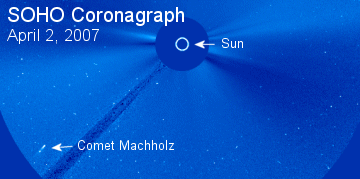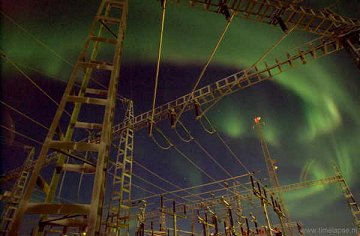 Did you miss last night's auroras? Next time get a wake-up call from Spaceweather PHONE.
Did you miss last night's auroras? Next time get a wake-up call from Spaceweather PHONE.
DID YOU NOTICE? Last night's full Moon was the smallest full Moon of 2007. Why? Because the Moon's orbit is an ellipse, not a circle, and this full Moon just happened to occur at the orbit's far point. On average, the Moon is as wide as the sun--that's why we have total eclipses--but look at these side-by-side photos from Vladimir Zivkovic of Croatia. "Last night's Moon was not big enough to cover the sun," he says.
COMET MACHHOLZ: Comet 96P/Machholz is swinging past the sun this week well inside the orbit of Mercury. This makes the flyby difficult to see--unless you're SOHO. The Solar and Heliospheric Observatory's coronagraph is able to block the sun's glare to reveal the plummeting comet:

See the movie!
Solar heating vaporizes comets and causes them to brighten. Comet 96P/Machholz is not expected to become spectacularly bright, but we've learned this year that anything can happen when comets approach the sun. Join SOHO for a ringside seat.
MAGNETIC STORM: For the past several days, a solar wind stream has been buffeting Earth's magnetic field, causing it to shake. The shaking was so severe in Scandinavia last night, compass needles shifted "more than two degrees," reports Jan Lameer, who took this picture from Porjus in the Lapland of Sweden:

Photo details: Nikon D1H, 14mm lens, 1600 ISO, 4 sec exposure.
"There must have been a lot of electricity flowing through the upper atmosphere!" he says.
More auroras are possible tonight. Earth is still inside the solar wind stream, and a good gust could spark another display.
April 2007 Aurora Gallery
[aurora alerts] [night-sky cameras]

